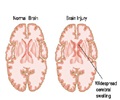
By producing complex multimodal fibers that could be less than the width of a hair, they have created a system that could deliver optical signals and drugs directly into the brain, along with simultaneous electrical readout to continuously monitor the effects of the various inputs.
The new technology is described in a paper appearing in the journal Nature Biotechnology, written by MIT’s Polina Anikeeva and 10 others. An earlier paper by the team described the use of similar technology for use in spinal cord research.
In addition to transmitting different kinds of signals, the new fibers are made of polymers that closely resemble the characteristics of neural tissues, Anikeeva says, allowing them to stay in the body much longer without harming the delicate tissues around them.
“We’re building neural interfaces that will interact with tissues in a more organic way than devices that have been used previously,” says Anikeeva, an assistant professor of materials science and engineering. To do that, her team made use of novel fiber-fabrication technology pioneered by MIT professor of materials science (and paper co-author) Yoel Fink and his team, for use in photonics and other applications.
Advertisement











